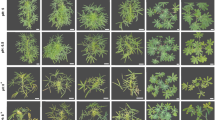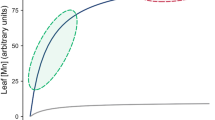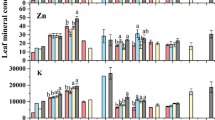Abstract
Aims
Plants deploying a phosphorus (P)-mobilising strategy via carboxylate release have relatively high leaf manganese concentrations ([Mn]). Thus, leaf [Mn] is a proxy for the amount of rhizosheath carboxylates. Whether the concentrations of other leaf micronutrient, such as iron ([Fe]), zinc ([Zn]) and copper ([Cu]), show a similar signal for rhizosheath carboxylates is unclear.
Methods
We grew a large number of chickpea genotypes in two glasshouse studies with different growth media, P sources and P levels. Seven weeks after sowing, we determined concentrations of micronutrients in mature leaves, and the quantity and composition of rhizosheath carboxylates.
Results
For 100 genotypes grown in river sand with low P supply, leaf [Fe] (R2 = 0.36) and [Zn] (R2 = 0.22), like leaf [Mn] (R2 = 0.38), were positively correlated with the total amount of rhizosheath carboxylates. For 20 genotypes grown in a soil mixture, leaf [Fe], [Zn], [Cu] and [Mn] showed positive correlations with total rhizosheath carboxylates that were stronger under moderately low P (R2 = 0.59, 0.59, 0.54, 0.72) than severely low P (R2 = 0.39, 0.28, 0.20, 0.36) or sufficient P (R2 = 0.36, 0.00, 0.01, 0.50) supply. Malonate was the predominant carboxylate in the rhizosheath and was significantly correlated with leaf micronutrient concentrations in both experiments.
Conclusions
In addition to leaf [Mn], leaf [Fe] and [Zn] can be used as alternative and easily measurable proxies for belowground carboxylate-releasing processes in chickpea under low-P supply, particularly on moderately low-P soils.







Similar content being viewed by others
References
Andresen E, Peiter E, Kupper H (2018) Trace metal metabolism in plants. J Exp Bot 69:909–954. https://doi.org/10.1093/jxb/erx465
Baxter IR, Vitek O, Lahner B, Muthukumar B, Borghi M, Morrissey J, Guerinot ML, Salt DE (2008) The leaf ionome as a multivariable system to detect a plant's physiological status. Proc Natl Acad Sci U S A 105:12081–12086. https://doi.org/10.1073/pnas.0804175105
Cawthray GR (2003) An improved reversed-phase liquid chromatographic method for the analysis of low-molecular mass organic acids in plant root exudates. J Chromatogr A 1011:233–240. https://doi.org/10.1016/s0021-9673(03)01129-4
Dakora FD, Phillips DA (2002) Root exudates as mediators of mineral acquisition in low-nutrient environments. Plant Soil 245:35–47. https://doi.org/10.1023/A:1020809400075
de Mendiburu F (2017) Agricolae: Statistical procedures for agricultural research. R package version 1:2–8. http://CRAN.Rproject.org/packages/agricolae. Accessed 18 Jan 2020
Delgado M, Zúñiga-Feest A, Reyes-Díaz M, Barra PJ, Ruiz S, Bertin-Benavides A, Valle S, Pereira M, Lambers H (2021) Ecophysiological performance of proteaceae species from southern South America growing on substrates derived from young volcanic materials. Front Plant Sci 12:636056. https://doi.org/10.3389/fpls.2021.636056
Devi VS, Rao PA, Sharma SP, Sharma HC (2014) Interaction of acid exudates in chickpea with biological activity of Bacillus thuringiensis towards Helicoverpa armigera. J Appl Entomol 138:289–296. https://doi.org/10.1111/jen.12056
Dinkelaker B, Römheld V, Marschner H (1989) Citric acid excretion and precipitation of calcium citrate in the rhizosphere of white lupin (Lupinus albus L.). Plant Cell Environ 12:285–292. https://doi.org/10.1111/j.1365-3040.1989.tb01942.x
Dinkelaker B, Hengeler C, Marschner H (1995) Distribution and function of proteoid roots and other root clusters. Plant Biol 108:183–200. https://doi.org/10.1111/j.1438-8677.1995.tb00850.x
Epstein E, Bloom AJ (2005) Mineralnutrition of plants: principles andperspectives. Sinauer Associates, Sunderland, p 50
Fageria NK, Baligar VC, Clark RB (2002) Micronutrients in crop production. Adv Agron 77:185–268. https://doi.org/10.1016/S0065-2113(02)77015-6
Gardner WK, Boundy KA (1983) The acquisition of phosphorus by Lupinus albus L. IV. The effect of interplanting wheat and white lupin on the growth and mineral composition of the two species. Plant Soil 70:391–402. https://doi.org/10.1007/bf02374894
Gardner W, Parbery D, Barber D (1982a) The acquisition of phosphorus by Lupinus albus L. I. some characteristics of the soil/root interface. Plant Soil 68:19–32. https://doi.org/10.1007/bf02374724
Gardner W, Parbery D, Barber D (1982b) The acquisition of phosphorus by Lupinus albus L. II. The effect of varying phosphorus supply and soil type on some characteristics of the soil/root interface. Plant Soil 68:33–41. https://doi.org/10.1007/BF02374894
Gardner W, Barber D, Parbery D (1983) The acquisition of phosphorus by Lupinus albus L. III. The probable mechanism by which phosphorus movement in the soil/root interface is enhanced. Plant Soil 70:107–124. https://doi.org/10.1007/BF02374754
Gross A, Tiwari S, Shtein I, Erel R (2021) Direct foliar uptake of phosphorus from desert dust. New Phytol. https://doi.org/10.1111/nph.17344
Haldar M, Mandal LN (1981) Effect of phosphorus and zinc on the growth and phosphorus, zinc, copper, iron and manganese nutrition of rice. Plant Soil 59:415–425. https://doi.org/10.1007/BF02184546
Hayes P, Turner BL, Lambers H, Laliberté E (2014) Foliar nutrient concentrations and resorption efficiency in plants of contrasting nutrient-acquisition strategies along a 2-million-year dune chronosequence. J Ecol 102:396–410. https://doi.org/10.1111/1365-2745.12196
He XL, Fan SK, Zhu J, Guan MY, Liu XX, Zhang YS, Jin CW (2017) Iron supply prevents cd uptake in Arabidopsis by inhibiting IRT1 expression and favoring competition between Fe and cd uptake. Plant Soil 416:453–462. https://doi.org/10.1007/s11104-017-3232-y
Huang G, Hayes PE, Ryan MH, Pang J, Lambers H (2017) Peppermint trees shift their phosphorus-acquisition strategy along a strong gradient of plant-available phosphorus by increasing their transpiration at very low phosphorus availability. Oecologia 185:387–400. https://doi.org/10.1007/s00442-017-3961-x
Jarrell WM, Beverly RB (1981) The dilution effect in plant nutrition studies. Adv Agron 34:197–224. https://doi.org/10.1016/S0065-2113(08)60887-1
Jeong J, Merkovich A, Clyne M, Connolly EL (2017) Directing iron transport in dicots: regulation of iron acquisition and translocation. Curr Opin Plant Biol 39:106–113. https://doi.org/10.1016/j.pbi.2017.06.014
Jones DL (1998) Organic acids in the rhizosphere – a critical review. Plant Soil 205:25–44. https://doi.org/10.1023/A:1004356007312
Jones DL, Brassington DS (1998) Sorption of organic acids in acid soils and its implications in the rhizosphere. Eur J Soil Sci 49:447–455. https://doi.org/10.1046/j.1365-2389.1998.4930447.x
Jones DL, Dennis PG, Owen AG, van Hees PAW (2003) Organic acid behavior in soils – misconceptions and knowledge gaps. Plant Soil 248:31–41. https://doi.org/10.1023/a:1022304332313
Karagiannidis N, Hadjisavva-Zinoviadi S (1998) The mycorrhizal fungus Glomus mosseae enhances growth, yield and chemical composition of a durum wheat variety in 10 different soils. Nutr Cycl Agroecosyst 52:1–7. https://doi.org/10.1023/a:1016311118034
Kidd DR, Ryan MH, Hahne D, Haling RE, Lambers H, Sandral GA, Simpson RJ, Cawthray GR (2018) The carboxylate composition of rhizosheath and root exudates from twelve species of grassland and crop legumes with special reference to the occurrence of citramalate. Plant Soil 424:389–403. https://doi.org/10.1007/s11104-017-3534-0
Koundal KR, Sinha SK (1983) Evaluation of the significance of malic-acid secretion in chickpea. Physiol Plant 58:189–192. https://doi.org/10.1111/j.1399-3054.1983.tb04167.x
Lambers H, Shane MW, Cramer MD, Pearse SJ, Veneklaas EJ (2006) Root structure and functioning for efficient acquisition of phosphorus: matching morphological and physiological traits. Ann Bot 98:693–713. https://doi.org/10.1093/aob/mcl114
Lambers H, Hayes PE, Laliberte E, Oliveira RS, Turner BL (2015) Leaf manganese accumulation and phosphorus-acquisition efficiency. Trends Plant Sci 20:83–90. https://doi.org/10.1016/j.tplants.2014.10.007
Lambers H, Wright IJ, Guilherme Pereira C, Bellingham PJ, Bentley LP, Boonman A, Cernusak LA, Foulds W, Gleason SM, Gray EF, Hayes PE, Kooyman RM, Malhi Y, Richardson SJ, Shane MW, Staudinger C, Stock WD, Swarts ND, Turner BL, Turner J, Veneklaas EJ, Wasaki J, Westoby M, Xu Y (2021) Leaf manganese concentrations as a tool to assess belowground plant functioning in phosphorus-impoverished environments. Plant Soil. https://doi.org/10.1007/s11104-020-04690-2
Leitenmaier B, Küpper H (2013) Compartmentation and complexation of metals in hyperaccumulator plants. Front Plant Sci 4:374. https://doi.org/10.3389/fpls.2013.00374
Lindsay WL, Norvell WA (1978) Development of a DTPA soil test for zinc, iron, manganese, and copper. Soil Sci Soc Am J 42:421–428. https://doi.org/10.2136/sssaj1978.03615995004200030009x
Lindström BEM, Frankow-Lindberg BE, Dahlin AS, Wivstad M, Watson CA (2013) Micronutrient concentrations in common and novel forage species and varieties grown on two contrasting soils. Grass Forage Sci 68:427–436. https://doi.org/10.1111/gfs.12006
Lyu Y, Tang H, Li H, Zhang F, Rengel Z, Whalley WR, Shen J (2016) Major crop species show differential balance between root morphological and physiological responses to variable phosphorus supply. Front Plant Sci 7:1939. https://doi.org/10.3389/fpls.2016.01939
Mimmo T, Hann S, Jaitz L, Cesco S, Gessa CE, Puschenreiter M (2011) Time and substrate dependent exudation of carboxylates by Lupinus albus L. and Brassica napus L. Plant Physiol Biochem 49:1272–1278. https://doi.org/10.1016/j.plaphy.2011.08.012
Neumann G, Römheld V (1999) Root excretion of carboxylic acids and protons in phosphorus-deficient plants. Plant Soil 211:121–130. https://doi.org/10.1023/A:1004380832118
Neumann G, George TS, Plassard C (2009) Strategies and methods for studying the rhizosphere-the plant science toolbox. Plant Soil 321:431–456. https://doi.org/10.1007/s11104-009-9953-9
Oburger E, Jones DL (2018) Sampling root exudates – mission impossible? Rhizosphere 6:116–133. https://doi.org/10.1016/j.rhisph.2018.06.004
Oburger E, Schmidt H (2016) New methods to unravel rhizosphere processes. Trends Plant Sci 21:243–255. https://doi.org/10.1016/j.tplants.2015.12.005
Oliveira RS, Galvao HC, de Campos MC, Eller CB, Pearse SJ, Lambers H (2015) Mineral nutrition of campos rupestres plant species on contrasting nutrient-impoverished soil types. New Phytol 205:1183–1194. https://doi.org/10.1111/nph.13175
Pang JY, Ryan MH, Siddique KHM, Simpson RJ (2017) Unwrapping the rhizosheath. Plant Soil 418:129–139. https://doi.org/10.1007/s11104-017-3358-y
Pang J, Bansal R, Zhao H, Bohuon E, Lambers H, Ryan MH, Ranathunge K, Siddique KHM (2018) The carboxylate-releasing phosphorus-mobilizing strategy can be proxied by foliar manganese concentration in a large set of chickpea germplasm under low phosphorus supply. New Phytol 219:518–529. https://doi.org/10.1111/nph.15200
Pearse SJ, Veneklaas EJ, Cawthray G, Bolland MD, Lambers H (2007) Carboxylate composition of root exudates does not relate consistently to a crop species' ability to use phosphorus from aluminium, iron or calcium phosphate sources. New Phytol 173:181–190. https://doi.org/10.1111/j.1469-8137.2006.01897.x
Prescott CE, Grayston SJ, Helmisaari HS, Kaštovská E, Körner C, Lambers H, Meier IC, Millard P, Ostonen I (2020) Surplus carbon drives allocation and plant-soil interactions. Trends Ecol Evol 35:1110–1118. https://doi.org/10.1016/j.tree.2020.08.007
Puig S, Peñarrubia L (2009) Placing metal micronutrients in context: transport and distribution in plants. Curr Opin Plant Biol 12:299–306. https://doi.org/10.1016/j.pbi.2009.04.008
R Development Core Team (2020) R: a language and environment for statistical computing. Vienna, Austria: R foundation for statistical computing. http://www.R-project.org/. Accessed 18 Jan 2020
Saarnio S, Wittenmayer L, Merbach W (2004) Rhizospheric exudation of Eriophorum vaginatum L. – potential link to methanogenesis. Plant Soil 267:343–355. https://doi.org/10.1007/s11104-005-0140-3
Sadras V, Alston J, Aphalo P, Connor D, Denison RF, Fischer T, Gray R, Hayman P, Kirkegaard J, Kirchmann H, Kropff M, Lafitte HR, Langridge P, Lenne J, Mínguez MI, Passioura J, Porter JR, Reeves T, Rodriguez D, Ryan M, Villalobos FJ, Wood D (2020) Making science more effective for agriculture. Adv Agron 163:153–177. https://doi.org/10.1016/bs.agron.2020.05.003
Shane MW, Lambers H (2005) Manganese accumulation in leaves of Hakea prostrata (Proteaceae) and the significance of cluster roots for micronutrient uptake as dependent on phosphorus supply. Physiol Plant 124:441–450. https://doi.org/10.1111/j.1399-3054.2005.00527.x
Shane MW, Lambers H, Cawthray GR, Kuhn AJ, Schurr U (2008) Impact of phosphorus mineral source (Al–P or Fe–P) and pH on cluster-root formation and carboxylate exudation in Lupinus albus L. Plant Soil 304:169–178. https://doi.org/10.1007/s11104-007-9535-7
Shen J, Yuan L, Zhang J, Li H, Bai Z, Chen X, Zhang W, Zhang F (2011) Phosphorus dynamics: from soil to plant. Plant Physiol 156:997–1005. https://doi.org/10.1104/pp.111.175232
Socha AL, Guerinot ML (2014) Mn-euvering manganese: the role of transporter gene family members in manganese uptake and mobilization in plants. Front Plant Sci 5:106. https://doi.org/10.3389/fpls.2014.00106
Stevenson PC, D'Cunha RF, Grzywacz D (2010) Inactivation of baculovirus by isoflavonoids on chickpea (Cicer arietinum) leaf surfaces reduces the efficacy of nucleopolyhedrovirus against Helicoverpa armigera. J Chem Ecol 36:227–235. https://doi.org/10.1007/s10886-010-9748-8
Sun RL, Zhou QX, Jin CX (2006) Cadmium accumulation in relation to organic acids in leaves of Solanum nigrum L. as a newly found cadmium hyperaccumulator. Plant Soil 285:125–134. https://doi.org/10.1007/s11104-006-0064-6
Suriyagoda LDB, Lambers H, Renton M, Ryan MH (2012) Growth, carboxylate exudates and nutrient dynamics in three herbaceous perennial plant species under low, moderate and high phosphorus supply. Plant Soil 358:100–112. https://doi.org/10.1007/s11104-012-1311-7
Thomine S, Vert G (2013) Iron transport in plants: better be safe than sorry. Curr Opin Plant Biol 16:322–327. https://doi.org/10.1016/j.pbi.2013.01.003
Tian S, Lu L, Labavitch J, Yang X, He Z, Hu H, Sarangi R, Newville M, Commisso J, Brown P (2011) Cellular sequestration of cadmium in the hyperaccumulator plant species Sedum alfredii. Plant Physiol 157:1914–1925. https://doi.org/10.1104/pp.111.183947
Touchton JT, Johnson JW, Cunfer BM (1980) The relationship between phosphorus and copper concentrations in wheat. Commun Soil Sci Plant Anal 11:1051–1066. https://doi.org/10.1080/00103628009367104
Tsai H-H, Schmidt W (2017) One way. Or another? Iron uptake in plants. New Phytol 214:500–505. https://doi.org/10.1111/nph.14477
Veneklaas EJ, Stevens J, Cawthray GR, Turner S, Grigg AM, Lambers H (2003) Chickpea and white lupin rhizosphere carboxylates vary with soil properties and enhance phosphorus uptake. Plant Soil 248:187–197. https://doi.org/10.1023/A:1022367312851
Wang Y, Lambers H (2019) Root-released organic anions in response to low phosphorus availability: recent progress, challenges and future perspectives. Plant Soil 447:135–156. https://doi.org/10.1007/s11104-019-03972-8
Wen Z, Li H, Shen Q, Tang X, Xiong C, Li H, Pang J, Ryan MH, Lambers H, Shen J (2019) Tradeoffs among root morphology, exudation and mycorrhizal symbioses for phosphorus-acquisition strategies of 16 crop species. New Phytol 223:882–895. https://doi.org/10.1111/nph.15833
Wen Z, Pang J, Tueux G, Liu Y, Shen J, Ryan MH, Lambers H, Siddique KHM (2020) Contrasting patterns in biomass allocation, root morphology and mycorrhizal symbiosis for phosphorus acquisition among 20 chickpea genotypes with different amounts of rhizosheath carboxylates. Funct Ecol 34:1311–1324. https://doi.org/10.1111/1365-2435.13562
White PJ (2012a) Long-distance transport in the xylem and phloem. In: Marschner P (ed) Marschner's mineral nutrition of higher plants, 3rd edn. Academic Press, San Diego, pp 49–70
White PJ (2012b) Ion uptake mechanisms of individual cells and roots: short-distance transport. In: Marschner P (ed) Marschner's mineral nutrition of higher plants, 3rd edn. Academic Press, San Diego, pp 7–44
Wouterlood M, Cawthray GR, Scanlon TT, Lambers H, Veneklaas EJ (2004a) Carboxylate concentrations in the rhizosphere of lateral roots of chickpea (Cicer arietinum) increase during plant development, but are not correlated with phosphorus status of soil or plants. New Phytol 162:745–753. https://doi.org/10.1111/j.1469-8137.2004.01070.x
Wouterlood M, Cawthray GR, Turner S, Lambers H, Veneklaas EJ (2004b) Rhizosphere carboxylate concentrations of chickpea are affected by genotype and soil type. Plant Soil 261:1–10. https://doi.org/10.1023/B:PLSO.0000035568.28893.f6
Wouterlood M, Lambers H, Veneklaas EJ (2005) Plant phosphorus status has a limited influence on the concentration of phosphorus-mobilising carboxylates in the rhizosphere of chickpea. Funct Plant Biol 32:153–159. https://doi.org/10.1071/Fp04084
Yu RP, Li XX, Xiao ZH, Lambers H, Li L (2020) Phosphorus facilitation and covariation of root traits in steppe species. New Phytol 226:1285–1298. https://doi.org/10.1111/nph.16499
Zhang D, Zhang C, Tang X, Li H, Zhang F, Rengel Z, Whalley WR, Davies WJ, Shen J (2016) Increased soil phosphorus availability induced by faba bean root exudation stimulates root growth and phosphorus uptake in neighbouring maize. New Phytol 209:823–831. https://doi.org/10.1111/nph.13613
Zhang W, Chen X-X, Liu Y-M, Liu D-Y, Chen X-P, Zou C-Q (2017) Zinc uptake by roots and accumulation in maize plants as affected by phosphorus application and arbuscular mycorrhizal colonization. Plant Soil 413:59–71. https://doi.org/10.1007/s11104-017-3213-1
Zhang W, Zou C, Chen X, Liu Y, Liu D, Yang H, Deng Y, Chen X (2020) Phosphorus application decreased copper concentration but not iron in maize grain. Agronomy 10:1716. https://doi.org/10.3390/agronomy10111716
Zhou T, Du Y, Ahmed S, Liu T, Ren M, Liu W, Yang W (2016) Genotypic differences in phosphorus efficiency and the performance of physiological characteristics in response to low phosphorus stress of soybean in southwest of China. Front Plant Sci 7:1776. https://doi.org/10.3389/fpls.2016.01776
Zhou Y, Neuhauser B, Neumann G, Ludewig U (2020) LaALMT1 mediates malate release from phosphorus-deficient white lupin root tips and metal root to shoot translocation. Plant Cell Environ 43:1691–1706. https://doi.org/10.1111/pce.13762
Acknowledgments
This work was funded by the Australian Research Council Linkage Projects (LP200100341), the National Natural Science Foundation of China (31772402, 31330070), and National Key Research and Development Program of China (2016YFE0101100, 2017YFD0200200). We thank Rob Creasy and Bill Piasini for help with maintaining the plants in the glasshouse, Greg Cawthray for help with the analysis of carboxylates, Michael Smirk for help with the micronutrient analyses, and Dr. Jing Dai for the constructive comments on results discussion. We also greatly appreciate the support from the Chinese Scholarship Council (CSC) providing a Ph.D. student visiting scholarship to Zhihui Wen.
Author information
Authors and Affiliations
Contributions
Z.W., J.P., M.H.R., J.S., K.H.M.S. and H.L. designed the study; Z.W. and J.P. performed the experiments and collected the data; Z.W., J.P., M.H.R., J.S., K.H.M.S. and H.L. analysed and interpreted the data; Z.W. led the writing of the manuscript. All authors contributed critically to the drafts and gave final approval for publication.
Corresponding authors
Additional information
Responsible Editor: Enzo Lombi
Publisher’s note
Springer Nature remains neutral with regard to jurisdictional claims in published maps and institutional affiliations.
Supplementary Information
ESM 1
(DOCX 1228 kb)
Rights and permissions
About this article
Cite this article
Wen, Z., Pang, J., Ryan, M.H. et al. In addition to foliar manganese concentration, both iron and zinc provide proxies for rhizosheath carboxylates in chickpea under low phosphorus supply. Plant Soil 465, 31–46 (2021). https://doi.org/10.1007/s11104-021-04988-9
Received:
Accepted:
Published:
Issue Date:
DOI: https://doi.org/10.1007/s11104-021-04988-9




